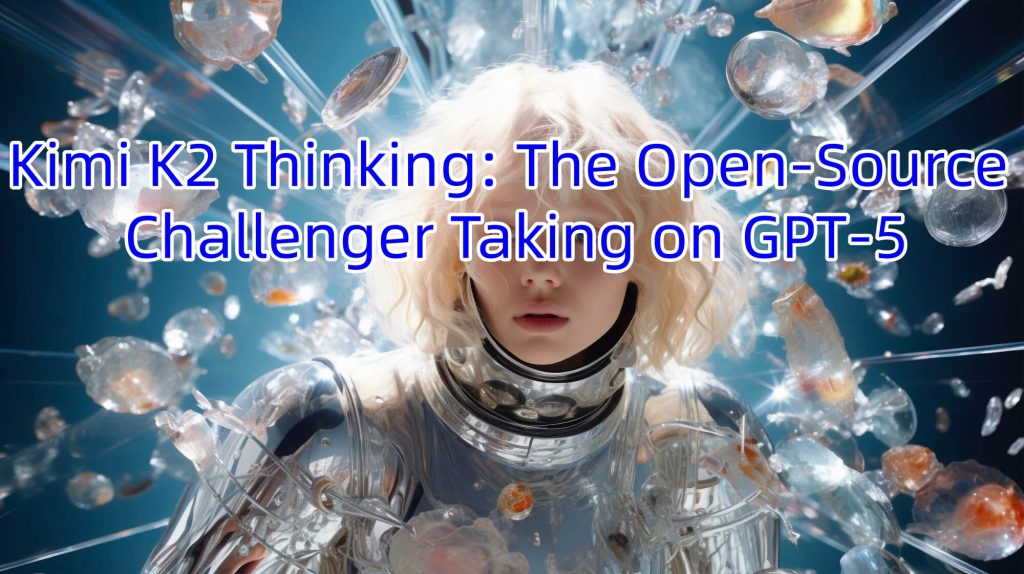The AI community is witnessing a pivotal moment. On November 6, 2025, Hugging Face co-founder Thomas Wolf captured the sentiment perfectly, stating on X: “Is this another DeepSeek-style glorious moment? Open-source software once again surpasses closed-source software.” This declaration came with the release of Kimi K2 Thinking, a powerful new open-source model that is challenging the dominance of proprietary giants like GPT-5.
Benchmark Dominance: Outperforming GPT-5
Kimi K2 Thinking has delivered impressive results across multiple benchmarks, matching and even surpassing State-of-the-Art (SOTA) closed-source models. A standout achievement is on the HLE (Humanity’s Last Exam) text-only subset, where its tool-enhanced version scored 44.9%, surpassing GPT-5’s 41.7%. This performance solidifies its position as a top-tier open-source reasoning model.
Architecture and Design: Efficiency at Scale
Built upon the Kimi K2 model, Kimi K2 Thinking is specifically fine-tuned to enhance Agentic and reasoning capabilities. Here’s a breakdown of its core architecture:
-
Massive yet Efficient Model: It is a Mixture-of-Experts (MoE) model with a total of 1 trillion parameters, but only activates approximately 32 billion parameters per inference. This design maintains vast knowledge capacity while controlling computational costs.
-
Extended Context and Quantization: It supports a 256k context window and utilizes native INT4 quantization, which reportedly boosts inference speed by about 2x with minimal performance loss, making it more accessible for deployment.
-
Surprisingly Low Training Cost: According to a CNBC report citing insiders, the model was trained for just $4.6 million. This is notably lower than the $5.6 million reported for DeepSeek-V3’s training phase, highlighting incredible cost efficiency.
A Leap in Agent Capabilities
A core feature of Kimi K2 Thinking is its advanced Agent functionality. The developers claim it can perform 200-300 consecutive tool calls to solve complex problems. While RL-enhanced tool use is common in closed-source models like Grok-4, this marks a significant advancement for the open-source community, pushing the boundaries of what open models can achieve in long-horizon planning and task execution.
The DeepSeek Connection: Inheriting a Proven Blueprint
The model’s release has sparked discussions about its technical lineage, with many in the tech community noting its architectural similarities to DeepSeek’s models. LLM research engineer Sebastian Raschka provided a detailed analysis, pointing out key comparisons:
-
Increased experts per MoE layer (~384 vs. DeepSeek’s 256).
-
Larger vocabulary (160k vs. 129k).
-
Fewer activated parameters per token (32B vs. DeepSeek R1’s 37B).
-
Fewer dense FFN blocks before the MoE layers.
Raschka concluded, “In short, Kimi K2 is essentially a DeepSeek V3/R1 with slightly adjusted scaling. Its improvements seem to lie primarily in the data and training recipe.” This “standing on the shoulders of giants” approach is a testament to the power of open-source collaboration.
Engineering Excellence: The Secret Sauce
Beyond architectural choices, Kimi’s engineering prowess played a crucial role:
-
Unprecedented Training Stability: The model was pre-trained on 15.5 trillion tokens with “zero loss spikes,” a significant achievement for a model of this scale, avoiding costly training rollbacks.
-
Robust Long-Range Execution: The ability to stably execute hundreds of tool calls requires sophisticated engineering to handle exceptions and maintain context over long interactions.
Beyond the Hype: Understanding the Trade-Offs
A thorough evaluation of Kimi K2 Thinking must look beyond top benchmark scores.
-
The “Heavy” Mode Caveat: Many of its SOTA scores were achieved using a special “Heavy” mode, which runs up to 8 parallel inferences and aggregates the results. This is resource-intensive and not representative of the standard, single-instance performance that most users will experience. For context, xAI’s Grok-4 Heavy scored 50.7% on the HLE text-only subset.
-
The Efficiency-Accuracy Trade-off: Decisions like INT4 quantization and reducing attention heads (from 128 to 64) were made for efficiency. However, the technical report acknowledges that more attention heads generally lead to better quality, indicating a conscious trade-off.
-
Focused Specialization: While it excels in “Agent Reasoning” and “Agent Search,” its programming capabilities have not yet reached the top spot. Furthermore, unlike many frontier models, it remains a text-only model, which can be a limitation for tasks requiring visual or spatial understanding.
Conclusion: The New Open-Source Paradigm
The release of Kimi K2 Thinking feels like another collective win for the open-source AI community. It demonstrates a successful formula: build upon proven open-source architectures like DeepSeek’s, refine the training recipe with a clear performance goal, leverage engineering excellence to enhance stability and efficiency, and deliver a model that competes with the best in the world on specific, critical fronts.
It serves as both an inspiration and a valuable piece of the puzzle for the next generation of AI models. The next “DeepSeek moment” might not need to come from DeepSeek itself, signaling a vibrant and rapidly evolving open-source ecosystem.
Keywords: Kimi K2 Thinking, GPT-5, Open Source AI, Mixture of Experts, MoE, AI Agent, Benchmark, HLE, DeepSeek, AI Model Training, INT4 Quantization, AI Engineering.

